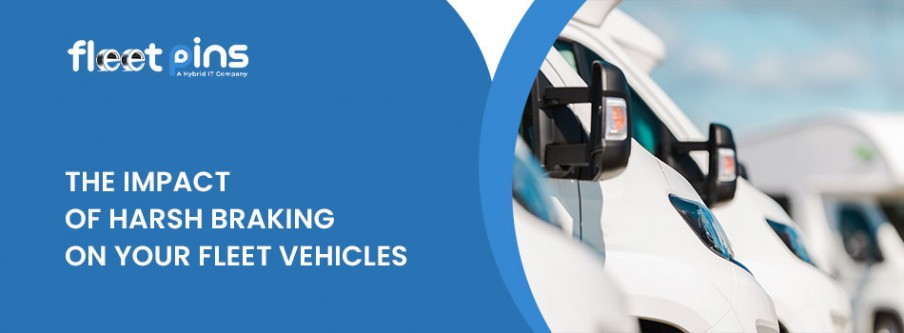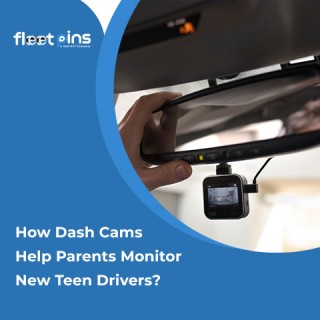
- On 2024-09-20
The Impact of Harsh Braking on Your Fleet Vehicles
Managing a fleet of vehicles, whether for delivery, transportation, or logistics, comes with numerous responsibilities. One of the most critical aspects that often goes unnoticed is driver behavior, specifically harsh braking. Harsh braking refers to the sudden, forceful application of brakes, causing a vehicle to decelerate rapidly. While occasional harsh braking is sometimes necessary in emergencies, frequent harsh braking can have significant impacts on your fleet’s vehicles, costs, and overall safety. At Fleet Pins, we will explore the consequences of harsh braking, the causes behind it, and how fleet management software can help prevent it.
Understanding Harsh Braking
Harsh braking is when a driver applies the brakes abruptly, causing the vehicle to stop much faster than under normal conditions. While this may happen during emergencies or unexpected situations, consistent harsh braking is an indicator of poor driving habits. When vehicles experience harsh braking frequently, it not only compromises safety but also has long-term effects on the health of the vehicle.
This driving behavior puts immense pressure on several parts of the vehicle, particularly the brakes, tires, and suspension. Over time, these components wear out faster, leading to more frequent repairs and higher maintenance costs. Harsh braking also decreases fuel efficiency, increases the risk of accidents, and reduces the resale value of fleet vehicles.
Causes of Harsh Braking in Your Fleet
Several factors contribute to harsh braking, ranging from driver habits to environmental conditions. Understanding the causes can help fleet managers take proactive steps to address the issue.
Distracted Driving
Drivers who are distracted by phones, food, or other activities are often slow to react to road conditions. When they finally notice an obstacle or a change in traffic, they tend to brake suddenly to avoid a collision.
Tailgating
Following too closely behind another vehicle is a common cause of harsh braking. When a driver is too close to the car in front, they have less time to react, leading to sudden braking.
Inexperience or Poor Driving Habits
Inexperienced drivers or those with poor driving habits often resort to harsh braking. Instead of gradually slowing down, they may brake hard in situations that don’t necessarily require such a response.
Road Conditions
Wet, icy, or uneven roads can force drivers to brake harshly, especially if they’re driving at speeds that aren’t appropriate for the conditions. In such cases, fleet managers need to train drivers to adjust their driving based on the environment.
Driver Fatigue
Tired drivers are less alert and more prone to harsh braking. Fatigue slows down reaction times, making it more likely for drivers to brake aggressively when they do realize they need to slow down or stop.
Aggressive Driving
Drivers who tend to speed, weave through traffic, or drive aggressively are more likely to engage in harsh braking. This kind of driving behavior not only leads to faster wear and tear on vehicles but also puts other road users at risk.
How Does Harsh Braking Impact Your Fleet?
Increased Wear and Tear
The braking system, tires, and suspension are heavily affected by harsh braking. Continuous sudden stops wear down brake pads and rotors quickly, leading to expensive repairs and frequent replacements. Tires can also wear unevenly, increasing the likelihood of tire blowouts.
Higher Fuel Consumption
Harsh braking, along with aggressive acceleration, is one of the top causes of poor fuel efficiency. Frequent sudden stops force the engine to work harder, burning more fuel than necessary. For fleet managers, this means increased fuel costs over time.
Reduced Safety
Frequent harsh braking increases the risk of accidents. A vehicle that stops abruptly can cause rear-end collisions or other types of accidents, putting drivers, passengers, and other road users at risk.
Lower Vehicle Resale Value
A fleet that experiences frequent harsh braking will have vehicles with more wear and tear, reducing their resale value. Potential buyers will likely notice the damage and be less willing to pay top dollar for used fleet vehicles.
Increased Insurance Premiums
The higher risk of accidents due to harsh braking can lead to higher insurance premiums for your fleet. Insurance companies take driving behavior into account when setting rates, and fleets with poor driving habits may be viewed as a greater risk.
How Fleet Management Software Helps Prevent Harsh Braking
Fleet management software by Fleet Pins is an invaluable tool that can help prevent harsh braking and other risky driving behaviors. These software systems offer a range of features that monitor, track, and improve driver performance, leading to safer and more efficient fleet operations.
- Real-Time Monitoring
- Driver Behavior Analysis
- Training and Coaching
- Telematics Integration
- Predictive Maintenance
By tracking vehicle usage and performance, fleet management software can predict when maintenance is needed, helping to reduce the wear and tear caused by harsh braking. If certain vehicles experience frequent harsh braking, the system can flag them for earlier brake inspections and maintenance, preventing costly breakdowns or accidents.
Conclusion
Harsh braking is a common but preventable issue in fleet management that can have significant negative effects on vehicle health, safety, and operational costs. By understanding the causes of harsh braking and utilizing fleet management software, fleet managers can reduce these occurrences and improve both safety and efficiency. Through real-time monitoring, driver coaching, and predictive maintenance, fleet management software is a key tool for maintaining the longevity and performance of your fleet vehicles.




